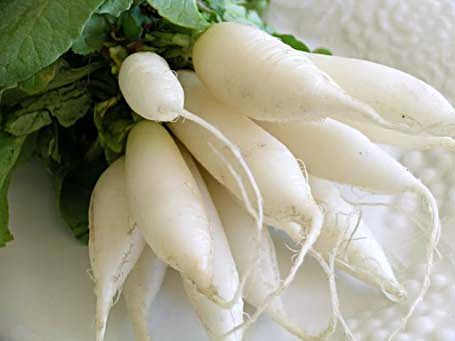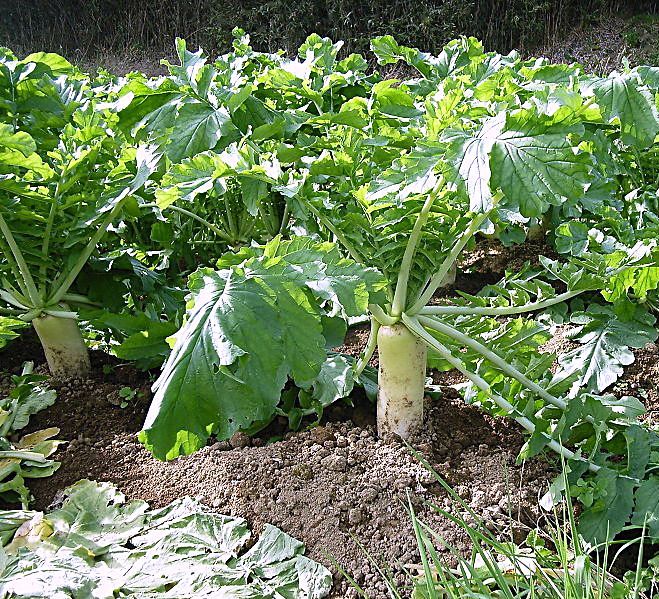 Almost every part of the radish plant is useful. The leaves and roots may be eaten raw or cooked as vegetable, or cooked with meat or fish. Besides its use as food, radish is also used in many other ways its oil does not dry up like ordinary oil. This is used in soap making the meat after juice extraction is used as fertilizer. Radish is also medicine for diseases of the liver and spleen. There are two kinds of radish. One is planted for its crop and the other for its leaves and roots.
Almost every part of the radish plant is useful. The leaves and roots may be eaten raw or cooked as vegetable, or cooked with meat or fish. Besides its use as food, radish is also used in many other ways its oil does not dry up like ordinary oil. This is used in soap making the meat after juice extraction is used as fertilizer. Radish is also medicine for diseases of the liver and spleen. There are two kinds of radish. One is planted for its crop and the other for its leaves and roots.
The different varieties we have are:
- Japanese radish — big and long, late harvested
- Chinese radish — fine, smooth and white, productive and has moderate
length of time for harvest - White icicle — early harvest, rounded, long with small roots.
- Bombay, 60 Days and others — can harvest within 100 days from planting, and mature 30 days from germination
Methods in Growing Radish
Land Preparation
- Plow and harrow the field lengthwise and crosswise, and leave it for seven days to allow the uprooted weeds to rot and their seeds to grow.
- Plow and harrow as before, repeat a third time but deeper.
- Make elevated beds about one-half meter away from each other.
- Put fertilizer where plants will be grown mix this with the soil by means of a rake.

Planting
A hectare of land would accommodate about 100 grams of seeds. Apply a kerosene can of compost before planting.
- Treat the seeds first in growth regulator like “Seet Treat.”
- Mix one teaspoon Orthocide 50 WP per kilo of seeds to check whatever diseases they may have.
- Prepare the planting of the seeds. To make them evenly apart, use a string attached to both ends — one at 10 cm, a second at 40 cm, etc.
- With the aid of a pointed stick, make a hole one and a half (1-½) cm deep and 10 cm apart, following the distance of the string.
- Drop two seeds in each hole and cover with fine soil. Water with fine spray so as not to dislodge the seeds or remove the top soil.
- Cover with straw about 5-10 cm thick between the rows of plants, with space of about 5 cm from the plant. Do not cover the seed especially if it has not germinated. Keep away chicken from scratching the seeds away. The straw or dried leaves serve to protect the plants from strong rain or intense heat, and from growing weeds.
- Water morning and afternoon in the first three (3) days after planting do not allow them to get dry. When the seeds germinate, water only in the morning.
- Ten days after all have germinated, water only in the afternoon when the ground is dry.
- Dig a canal around the plot about 30 cm wide and 40 cm deep to where the water will run in case of heavy rain.
- Before planting, mix a can of compost to every 2 sq. meters of plot. If animal manure will be used, apply this after the first plowing: one can per sq. meter. If chemical fertilizer will be used, have the soil analyzed first at the Bureau of Soils Laboratory. If not, the National Food and Agricultural Council recommends 8 bags of ammonium sulfate for every hectare of radish plants.
Maintenance
When the soil around the plant becomes compact, loosen it especially when the roots are beginning to grow. Be careful not to hurt the roots. If in spite of putting straw or dried leaves, weeds continue to grow, remove them manually.
Pests
To control insect pests, spray any of the following: Orthene 75 SP, SD, Tamaron 600 EC, Phosdrin 1.5 Ec, Hostathion 40 EC, or Vegetox, following instructions on the label, at an interval of 7 days. Trapping by means of light helps to control insect pests.
Diseases
A soil-borne or seed borne disease of radish attacks the new plant when the soil is very wet. As mentioned earlier, treat the seeds with orthocide or Spergon Fermate or Zerlate — one-half teaspoon per gallon water. The black rot disease has a V-shape on the leaves. The leaves turn yellow then fall off. There is a black ring around the body when the leaf is removed
Harvesting
Different varieties have different times of maturity, from 30 days from germination to 100 days after planting. Thus, it is good to know the variety to be planted, or try ten plants first. When overmature, radish is fibrous, porous and does not taste good. Pull up the crop when harvesting in early morning or late afternoon. Do not harvest when the sun is hot because it will wilt immediately. Wash, bundle and bring to market first hour in the morning. Do not pile them too high so as not bruise the crops, and to avoid heating for the crops under the pile.
Seeding
Get seeds only from healthy plants. Let these flower and bear seeds. Apply 2 grams ammonium sulfate, and water daily. Maintain with care until the fruits turn yellow. Select good seeds from good plants. When the pods are over mature, these will burst open. Dry the seeds in the sun to kill pests or disease. Before storing them, mix a little DDT or Orthocide 50 WP before packing. Put in a jar with fine charcoal at the bottom and over it a piece of cardboard with holes. Label jar. Seal the cover with masking tape until the next planting season.
Source: http://www.elgu2.ncc.gov.ph; Photos: en.wikipedia.org and smamuhiyogya.org